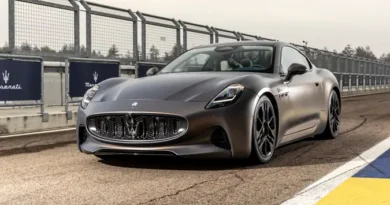Turbocharged Sports Cars
Introduction
Turbocharged sports cars have, over time, become the identifying feature of high-performance vehicles, achieving what customers never knew was possible-power, efficiency, and speed-all in one neat package. With every advance in automotive engineering, turbocharging has come to be the focus for all car drivers looking for a perfect balance between raw horsepower and finesse engineering. From all these turbocharged sports cars, there are many features that have won the hearts of enthusiasts through superior performance and efficient use of fuel and exciting driving experience. What is it about turbocharged sports cars, which make them the go-to for any adrenaline lover that does so with practicality?.
The Evolution of Turbocharged Sports Cars
While turbo-charged sports cars are the epitome of inventive expertise in engineering and performance, turbo charging actually originated in a way to enhance power of aircraft engines at higher altitudes. This is one of those innovations that just ended up in sports cars. The essence of turbo charging is a rather simple concept: a turbocharger urges an engine to burn more fuel by forcing more air into the combustion chamber, thereby producing more power.
This endows sports cars with incredible potency without needing oversized, heavy engines.
In the early days, turbocharged engines were often flamed for “turbo lag,” or the delay between acceleration and full power delivery. However, the modern turbo sports cars have technologies that minimize this problem to a close-to-almost instantaneous throttle response. Improvements in designing the engine have made the term turbo charging synonymous with performance and efficiency. Today, companies such as Porsche, Ferrari, and Ford used the innovative means of turbo charging technology, thereby allowing the turbocharged sports cars to come out to become more lively and exciting than ever before.
Performance Benefits of Turbocharged Sports Cars

First and foremost, performance superiority has been one of the most attractive reasons why people tend to choose turbo-charged sports cars. The extremely high horsepower and torque outputs without requiring a bigger engine are quite easy to compare. For example, a good example of this is with Ford’s Mustang Eco Boost. This car still delivers more than 300 horsepower at the same time as boasting a much smaller 2.3 litres of engine because of its turbocharger. This compact and yet powerful engine setup results in a light and agile car, a property that is held highly in the sports car world.
Moreover, one of the greatest benefits that turbocharged sports cars grant is accelerating at speeds almost beyond imagination, giving drivers a sweet rush of speed when they actually hit the pedal. It implies that more fuel can be added to the combustion process, resulting in an explosive gain in power. This places the turbocharged engines among the most efficient when it comes to generating power, reasons why most sports car manufacturers use turbo charging rather than naturally aspirated engines.
Porsche 911 Turbo is a perfect example of how the turbocharged sports cars still dominate the category of performance cars. The 911 Turbo takes a mere 2.7 seconds from standstill to the speed of 60 mph, a class that most of the non-turbo-charged sports cannot measure up to. So for all speed enthusiasts, the turbocharged model is still their first choice.
Fuel Efficiency and Environmental Benefits of Turbocharged Sports Cars
Although all these have made them deliver performance, their fuel economy in turbocharged sports cars has been quite a big advantage as well. A turbocharged engine is generally better in fuel economy than its naturally aspirated counterpart. For this reason, is because turbochargers allow for smaller engines that produce the same, if not more, power. With turbocharged sports cars, high performance may be combined with low fuel consumption. Both of these can be of interest to a driver in terms of cost and environmental impact.
Car manufacturers are under heavy pressure to reduce the negative environmental impact of vehicles while at the same time keeping or even improving the performance overall. Increasingly, more attention is paid to carbon emissions, which naturally requires stricter governmental regulations. It’s a better bet since turbocharging enables an engine to be optimized. For example, the BMW M2 is the perfect sporty turbocharged turbo charged vehicle whereby one can enjoy the great encounter between the sensible of responsible fuel consumption and the thrill of speed in the best-of-both-worlds scenario for the ‘eco-conscious’ driver.
Downsizing the engines and making it turbocharged is fast becoming a trend as manufacturers look to meet certain emissions standards. In this regard, the sports cars come with turbochargers and are the future of performance driving while it doesn’t compromise on the fun, power, and excitement that the drivers would crave but with lowered emissions.
Turbocharged Sports Cars
A second major area in which turbo sports cars dominate concerns their handling and driving dynamics. Lightened turbocharged engines tend to provide better weight distribution, which would enhance a car’s general balance as well as its cornering ability. Handling of a sports car is just about similar to raw power; the turbo models are highly capable of an excellent drive, particularly on winding roads or race tracks.
Most manufacturers fine-tune their turbocharged sports cars to actually outshine in the area of handling by pairing their turbocharged engines with superior suspension and lightweight material. Such an end result of the vehicle provides it the feeling of responses and controls, thereby giving drivers confidence in their push to limit. The turbocharged engine and the all-wheel drive system of the Nissan GT-R do make it one of the most agilely handle able vehicles that is available on roads today.
While turbocharger technology also used in cars like Audi S3 and Mercedes-AMG A45, it gives its owner great to favour handling, with exceptional power suitable for smaller, everyday sports cars. Simply in a few words, turbo charging is accessible to all drivers who want superior precision handling in his or her everyday routine, rather than a luxury item for a super elite few.
Affordability and Accessibility of Turbocharged Sports Cars
Of course, the ultimate examples of high-performance turbocharged sports cars are the Porsche 911 Turbo or Ferrari F8 Tribute but one thing is for sure, and that’s the fact that turbocharging technology has cut down into more affordable models. A high performance Ford Focus ST, Volkswagen Golf GTI, and Subaru WRX express turbocharged performance at a fraction of the price of a luxury sports car and the thrill of the turbo powered sports car now becomes for the average consumer more affordable than ever.
To that end, these budget-friendly turbocharged sports cars afford all of the benefits the high-end varieties provide-including acceleration, handling, and fuel efficiency-and make them available to a wider population. Advances in turbocharging technology mean that even the most budget-friendly models can deliver the excitement of a turbocharged engine, so drivers don’t have to crack open their piggy banks to enjoy the thrill.
Conclusion
The current offerings of turbochargers on sports cars represent the pinnacle of automobile innovation, incorporating all factors that balance power delivery, economy, and roadworthiness. This gives the manufacturer the opportunity to create lighter, friendlier to the environment, but intensely powerful sports cars, making turbocharged sports an ideal proposition for today’s driver seeking performance. Turbocharged sports cars will find a perfect balance of speed addiction by a car guy who wants his ride to have tremendous power without losing its economy. As long as the automotive continues to grow, so will the turbocharged sports car be on the road for many more years.





Pingback: Lamborghini Urus - AUTOENTHUSE